I love the idea, that when I sleep, a whole other world awakes. I’m not talking hemispheres here, but the amazing world of the nocturnal natural world. I usually read until quite late and sometimes I hear a curlew flying over our house or the magnificent, haunting scream of a distant fox. I am fascinated by this world and on Saturday, I was given the chance to delve into an element of this world – the world of the moth! I attended a family fun day at Forthill Park and met Rose, who is really knowledgeable and passionate about moths and butterflies. I stood behind the table and helped her a tiny bit, telling some people about butterflies and I really enjoyed it! Rose saw that I was keen and passionate too, so she offered me the loan of an actual moth trap!! Not a white sheet with a torch (which is all very good) but a proper one that would open my eyes a lot more, into this magical, unknown world – what flutters around my garden at night. I might not have shown it (I don’t show my emotions like other people), but I was so, so excited!!
We set the trap up the following night, thanks to Rose, who explained everything we needed to do. I stayed up a little later that night and also took the bat detector out, we recorded some pipestrelles and I knew that it would be a great night for moths in our garden. I could hardly sleep with increasing excitement, and although obviously, we have moths that fly into our house at night, I hoped that the treasure trove we found in the morning, would reveal so much more than many, many micro moths.

The next morning dawned and the birds were going crazy in the garden, mum unplugged the battery, took the electrics inside, and put a kitchen towel over the trap until they had calmed down. Our garden is full of activity at the moment, fledglings are growing up and second broods are in the make, so it’s very, very busy. There was no sign of it calming down so we went out and hoped for the best. We were all crowded around, gaping in, hungry for the sight of them and then all was revealed, lots and lots of sleeping moths lay among the egg cartons and we all gasped in delight. I think our collective gasping was a bit too much, because a fair few moths suddenly woke up and flew away. I shut my eyes tightly and didn’t look to see if any were predated, there probably were lots, but chicks need to be fed and I guess it’s a hearty meal for great tit…
We carefully, picked out a few distinguishable specimens and put them into jars, we realised that even with some bed-time swotting, it was going to be challenging to identify them. I have a limited knowledge of moths to be honest, I am learning, but you can check out my other two blogs on moths for more technical details (just scroll down the homepage – I am also learning about how to configure my blog!)
As we potted, photographed, researched, looked for distinguishing features, identified; I have to say, my heart was pumping with excitement. I felt like scientist, a taxonomist; it was exhilarating! I was flapping with excitement, almost as much as the birds were!
I am still identifying quite a lot of the ‘brown’ moths as they are a little more tricky, but I want to do it properly and increase my knowledge on how to look at the different moth groups. Our main finds were in the Noctuidae and Geometridae sub-species group and they were all beautiful, passive and let us delve into their world with no fuss at all. Their wings, all so delicate, made me cautious to take them out to photograph properly but I completely enjoyed gazing at their silent, sometimes fitting wing movements and the wiggles of their antennae.
Below are a few of the species that we found, each so different, each symmetrical and perfect. Wonderful!
Early Thorn (Selenia dentaria) – biggest picture. Right-top to the end of Early Thorn – Bee Moth (Aphomia sociella), Clouded Border (Lomaspilis marginata), Garden Carpet (Xanthoroe fluctuata) Bottom left – Large Yellow Under-wing (Noctua prunaba), Double Square Spot (Xestia triangulum)
We also spotted a Buff-tip moth (Phalera bucephala) in a garden a few doors down. How amazing ar these mimics of the broken birch twig. Just beautiful!

Huge thanks and appreciation to Rose and Butterfly Conservation N.I. for allowing me to study, record and get to know this amazing invertebrate species. I would also like to thanks them for all their encouragment, it’s fantastic! I am going to use the trap again and again over the next month, if I find anything interesting, I’ll post it on another blog I’ve been ‘building’ on species spotting – this includes birds, mammals and insects around Co Fermanagh, coming soon!
My next mission is to now get a trail camera, so I can catch a bigger glimpse into the mysterious, glorious world of the nocturnal. I better get saving!
Thanks for reading and for everyone’s brilliant support so far.
Dara


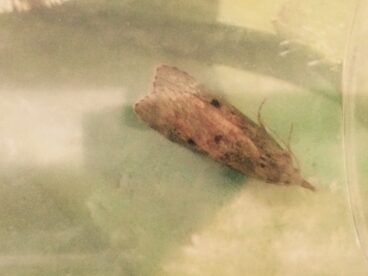
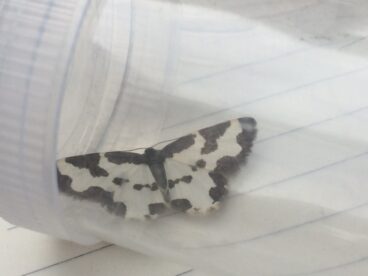
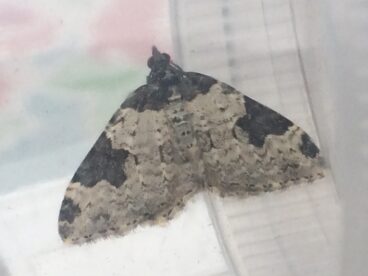
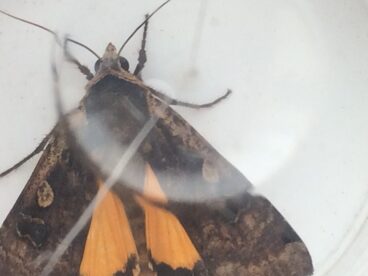
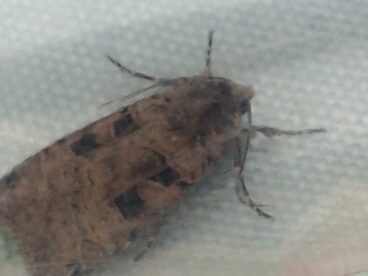
11 Responses
Hi Dara,
Great nocturnal moth detectionnn. Don’t you love it how supportive people can be once they find out you share their passion for nature?
Fritz (my husband) and I talked about your stories over breakfast. He says hello and wondered if you ever considered looking at moths or insects through a microscope. It’s a suprising world of structures and colours.
Hi Marjolijn! It’s fantastic, I did an interview for my local paper this morning, I was flapping all over the place and very nervous! My microscope got broken a while ago but yes, I love that idea! Tell Fritz I said hello too. Thanks. Dara :)))
Dara, I am loving your blog. there are so many wonderful people who will be able to help you in your explorations of nature. I can see a great future for you!
Thank you very much Abby! I am really looking forward to meeting with lots of new people who share my interests, I’m still so surprised! Dara
Hi Dara, yet another one of these incredible blogs. I’m sure you’ll discover hundreds of moth species very shortly, the diversity is incredible.
Best wishes,
James
Thank you James! Yes, I feel a whole world opening up. It’s fantastic!
Dara ☺️
Great post Dara, your posts are such an inspiration!!! 🙂
Dara does a lot of great work and he inspires many people.:)
Keep up the good work, perhaps by the time you are old enough to go to university we will have started an undergraduate degree in entomology for you to attend. At the moment the UK only has a post-graduate one.
Thank you Simon! I have always wanted to study physics but I’m still young. I love bio physics and when watching wildlife I also think about their ‘mechanics’ how they work and how technology has grown through the study of wildlife and nature.
Dara ☺️☺️
biophysics these days is pretty much molecular biology and has little (if any) contact with whole organisms. Also one of the major problems with biology degrees at lots of the ‘top’ universities is that is all about the molecules rather than the organisms and how they exist in nature. Very few places teach people how to identify the wildlife around them 🙁 One of the many reasons why I left Imperial College and moved to Harper Adams